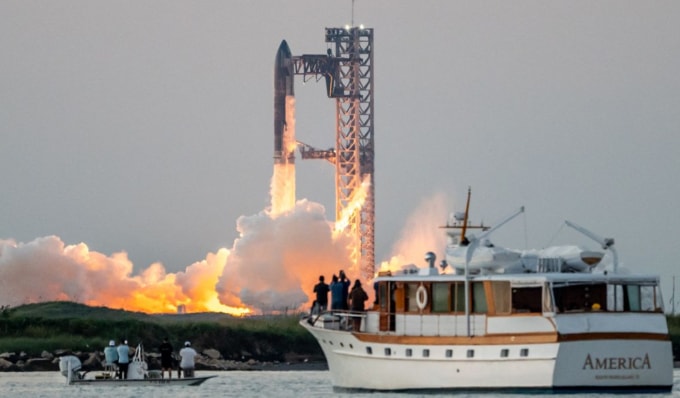SpaceX successfully launched the Starship rocket in its fifth test and returned the Super Heavy booster to the launch pad using a robotic arm.

SpaceX launched the 122-meter-tall Starship rocket for the fifth time from Starbase, Texas at 12:25 p.m. on October 13. This time, the rocket carried out a historic mission when it returned the Super Heavy booster to the launch pad using the "chopstick" robotic arm of the Mechazilla launch tower.
About seven minutes after launch, Super Heavy landed precisely near the Mechazilla tower and was caught by the robotic arm. "This is a historic day for engineering. It's unbelievable! On the first try, we successfully captured the Super Heavy booster back into the launch tower," Kate Tice, SpaceX's quality systems manager, shared during the live broadcast.
From the launch pad, SpaceX spokesman Dan Huot added: "Even in this day and age, what we just saw looks like magic."
In addition to catching the booster, SpaceX also aimed to launch the 164-foot-tall (50-meter) upper stage of Starship into space and then land it in the Indian Ocean. This would happen about 65 minutes after launch. The upper stage fired three of its six engines to hover over the ocean before tipping over and exploding.
SpaceX is developing Starship, which aims to help humans colonize the Moon and Mars. Starship is designed to be fully and quickly reusable, reducing the time between flights and reducing costs.
SpaceX aims to complete Starship on time using its usual development strategy: tweak and test on test flights, then repeat the process. The Starship on test flight five has undergone some significant modifications compared to previous versions. SpaceX spent more than 12,000 hours replacing the entire thermal protection system with newer-generation panels, a backup anti-wear layer, and additional protection between the wing structures.
Starship’s four previous test flights took place in April and November 2023, and March and June 2024. The rocket has performed better with each successive flight. The first flight lasted just four minutes because SpaceX detonated the rocket in mid-air after the two stages failed to separate. However, the fourth flight on June 6 was a complete success, with the upper stage reaching orbital velocity and both stages surviving the return to Earth, landing in designated areas.
Starship is SpaceX CEO Elon Musk's launch system with the ambition of taking humans to Mars for the first time. This is the tallest (120 m) and most powerful rocket ever built, capable of generating nearly 8,000 tons of thrust at launch.
NASA has chosen Starship to land astronauts on the Moon as part of its Artemis program. When Starship makes its journey to the Moon, it will stay in low Earth orbit while SpaceX launches separate support vehicles to refuel the ship. The earliest astronaut mission to land on the Moon is 2026.
TH (according to VnExpress)